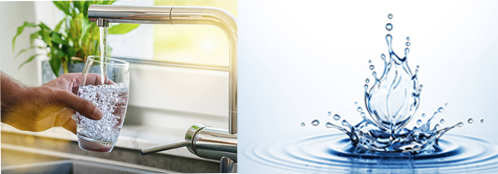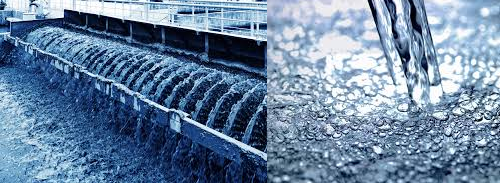Water treatment is generally divided
into drinking water treatment and industrial water treatment. Drinking water
treatment steps are generally physical processes (such as sedimentation and
filtration), chemical processes (such as disinfection and coagulation),
biological processes (such as slow sand filtration), industrial water treatment
steps are generally the main process of industrial water treatment.
I. Definition of Water Treatment:
Water treatment is the process of
improving water quality for specific end-use. End-uses may be drinking water,
industrial water supply, irrigation, river maintenance, water recreation, and
other uses, including safe return to the environment. Water treatment can
remove contaminants and undesirable constituents or reduce their concentration
to make the water suitable for its desired end-use. This treatment is essential
to human health, benefiting people from both drinking and irrigation.
Drinking water treatment.
Basic Definition: The production
of drinking water includes raw water sufficient to remove contaminants and has
no long-term risk of short-term or adverse health effects. In general, the
greatest microbial risk is associated with the ingestion of water contaminated
with human or animal (including bird) feces. Feces can be a source of
pathogens, viruses, protozoa, and worms. Destruction of microbial pathogens is
essential, and reactive chemicals (e.g., suspended solids) are often used to
remove bacteria, algae, viruses, fungi, and minerals, including iron and
manganese. These substances continue to cause enormous damage in several underdeveloped
countries that are unable to purify their water.
To ensure water quality, measures
are taken to treat the water and transport and distribute the treated water.
Therefore, it is common practice to leave residual disinfectants in the treated
water to kill bacterial contamination in the distribution process.
Domestic water supplied for tap
or other uses may be further treated before use, usually by an in-line
treatment process. This treatment may include water softening or ion exchange.
Many proprietary systems also claim to remove residual disinfectants and heavy
metal ions.
Basic Processes: Processes
related to contaminant removal include physical processes (e.g., sedimentation
and filtration), chemical processes (e.g., disinfection and coagulation), and
biological processes (e.g., slow sand filtration).
Combinations selected from the
following processes are used worldwide for municipal drinking water treatment.

Chemical industry.
A tank with a sand filter removes
precipitated iron (which does not work at the time).
Pre-chlorination can control
algae and prevent biological growth.
When small amounts of manganese
are present, aeration and pre-chlorination can remove dissolved iron.
Disinfection with chlorine,
ozone, and ultraviolet light disinfects pathogens, viruses, and other
pathogens.
(2) Physical.
Sedimentation for solids
separation, i.e., removal of suspended solids trapped in flocs.
Filtration removes particles
through the water, either through a washable, reusable sand bed or through a
specially designed washable filter.
Removal of suspended solids by
dissolved air flotation.
(3) Physicochemical.
Coagulant adjuncts - also known
as polyelectrolytes - improve coagulation to form a stronger coagulum.
Polyelectrolytes, or polymers as
they are called in the field, are usually composed of positively or negatively
charged materials, based purely on the water source's characteristics in the
treatment plant.
These are often used combined
with a primary coagulant such as ferric chloride, ferric sulfate, or alum.
(4) Biological.
The slow filtration of sand
metabolizing organic matter with biofilms.
(5) Technical.
Well-developed technologies for
drinking water allow for universal design and optional treatment technology
pilot testing for specific water sources. Besides, private companies offer
patented technology solutions to treat specific contaminants. Automation of
water treatment is common in developed countries. The water source's quality
across seasons, size, and environmental impact can determine capital and
operating costs. The end use of the treated water determines the necessary
quality monitoring technology, and local skills determine the level of
automation adopted.
(6) Desalination.
Brine can be treated to produce
fresh water. Two main processes are used, reverse osmosis or distillation. [1]
These two methods require more energy than treating local surface water and are
usually only used in high salinity areas such as coastal areas or groundwater.
(7) Portable water purifiers.
Living away from drinking water
sources usually requires some form of portable water treatment process. These
complex variations range from the simple addition of disinfectant tablets to a
hiker's water bottle to the complex multi-stage process of transporting it by
boat or plane to a disaster area.
1、Basic Process: The two main
processes for industrial water treatment are boiler water treatment and cooling
water treatment. A large amount of proper water treatment can cause solids and
bacteria to react in the piping and boiler rooms. If left untreated, steam
boilers may develop scale or corrosion. Scale can lead to degraded and
dangerous machine performance, while additional fuel is required to heat the
same water level due to increased thermal resistance. Poor-quality effluent can
become a breeding ground for bacteria such as Legionella, which can threaten
public health.
Corrosion in low-pressure boilers
can be caused by high levels of dissolved oxygen, acidity, and alkalinity.
Therefore, water treatment should remove the dissolved oxygen to maintain the
boiler water's proper pH and alkalinity. Without effective water treatment, the
cooling water system may scale, corrode, and scaling, becoming a breeding
ground for harmful bacteria. This reduces efficiency, shortens equipment life,
and makes operation unreliable and unsafe.

2. Boiler water treatment.
Boiler water treatment is an
industrial water treatment used to remove or chemically modify substances that
may damage the boiler. Different treatment methods are used in different
locations to avoid fouling, corrosion, or foaming. The external treatment of
the raw water supply planned for use inside the boiler focuses on removing
impurities before they reach the boiler. Internal treatment of the boiler
concentrates on limiting the water's tendency to dissolve the boiler, keeping
the impurities from causing trouble until they are removed from the boiler
contamination.
3. Cooling water treatment.
Water cooling is the method of
removing heat from parts and industrial equipment. In cases where air cooling
is ineffective, water may be a more efficient heat transfer fluid. In most
environments where people live, water has the advantage of a liquid with high
thermal conductivity and high specific heat capacity. As well as the option of
evaporative cooling. Low-cost coolant loops typically allow for single-use as waste
but can be pressurized and recycled, eliminate evaporative losses, and provide
greater portability and higher cleanliness. Non-pressurized recirculating
coolant circuits using evaporative cooling need to drain the waste stream to
remove evaporative concentrated impurities. Disadvantages of water-cooled
systems include accelerated corrosion and maintenance requirements and reduced
heat transfer by preventing biofouling and fouling formation. Chemical
additives that reduce these drawbacks can be toxic to wastewater. Water cooling
is commonly used to cool automotive internal combustion engines and large
industrial facilities such as nuclear and steam power plants, hydroelectric
generators, oil refineries, and chemical plants.
4. Main Technologies.
(1) Chemical treatment.
Chemical treatment is the
technique of making industrial water suitable for use or discharge. These
include chemical precipitation, chemical disinfection, chemical oxidation,
advanced oxidation, ion exchange, and chemical neutralization.
(2) Physical treatment.
Filtration removes
micro-particles from the water and can pass through sand, such as rapid gravity
filters and mechanical filters. Dissolved air flotation removes floating solids
from the water. This is achieved by dissolving air in the water under pressure
and releasing water/air at atmospheric pressure in the flotation tank. The
released air forms small air bubbles that attach to the float and float on the
water's surface, where they can be removed from scum devices and overflow devices.
(3) Biological treatment.
Chronic sand filters use
biological processes to purify raw water to produce drinking water. They work
with complex biofilms that grow naturally on the sand surface. The gel-like
biofilm, called hypocotyl or Schmutzdecke, is located a few millimeters above
the sand layer. The Schmutzdecke consists of bacteria, fungi, protozoa,
rotifers, and a range of aquatic insect larvae. As the biofilm ages, more algae
may grow and larger aquatic organisms, including mosses, snails, and Annelida.
As water passes through the hyphae, material particles are trapped in a viscous
matrix, and soluble organic matter is adsorbed. Bacteria, fungi, and protozoa
metabolize contaminants.
The depth of a slow sand filter
is usually 1 to 2 meters, and the hydraulic load rate is 0.2 to 0.4 m3/m2 per
hour. The filter loses performance as the biofilm thickens, reducing the flow
rate. Refit the filter by removing the biofilm and thin sand. Water is poured
back into the filter and recirculated to form a new biofilm. Also, the wet rake
method involves agitating the sand and flushing the biofilm for treatment.
(4) Physicochemical treatment.
Chemical flocculants are used to
produce flocs in the water and trap suspended solids. Chemical polyelectrolytes
are used to increase the coagulation of suspended solids and improve removal.
It consists of rapid mixing of the primary coagulant (e.g., ferric sulfate) and
the coagulant cationic polymer before entering the coagulation cell. The water
to be treated is rapidly mixed with the primary coagulant and polymer and
placed into a flocculation tank where the water is slowly swirled or mixed with
chemicals to form what is called Flocc, which settles to the bottom of the Floc
basin. After the water mixes and forms flocs, it passes to the next stage of
the settling basin. Here, the process has either a tube settler or a plate
settler. Water flows upward through these tubes and plates, allowing freshwater
to flow into the outflow logistics tank, which carries the settled water to the
filter for further treatment. During the sinking phase, the tubes/plates have a
large surface area for the Flocc to sink. These plates are usually at an angle
of 30-45°, allowing Flocc particles to collect into the tubes and plates,
ending up at the bottom of the settling tank. Typically, a sludge collection
system collects all of the settling flocc or sludge, and then the waste is
pumped or transferred to a tank or jar in the decant and disposed of. The
settled water enters a filter and is then passed through a filter for storage
in a water purification well where all the filtered water is collected for
other chemical additions: pH regulators, chlorine, etc. After that, appropriate
contact time and dissipation of the sludge is required. Afterward, with proper
contact time and dissipation time, the water is discharged from the freshwater
sink and header into storage tanks or distributed to the customer's faucet for
use.